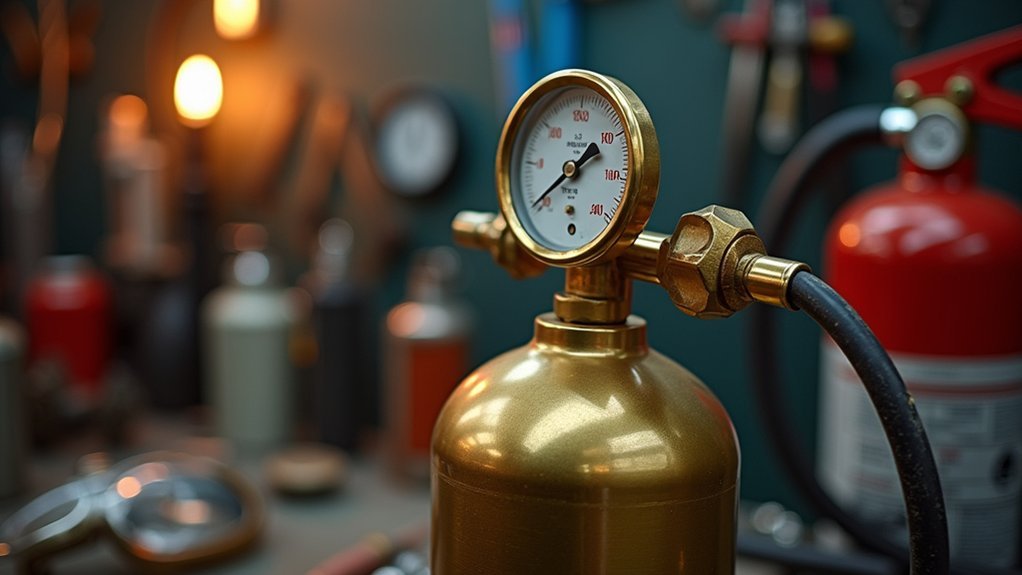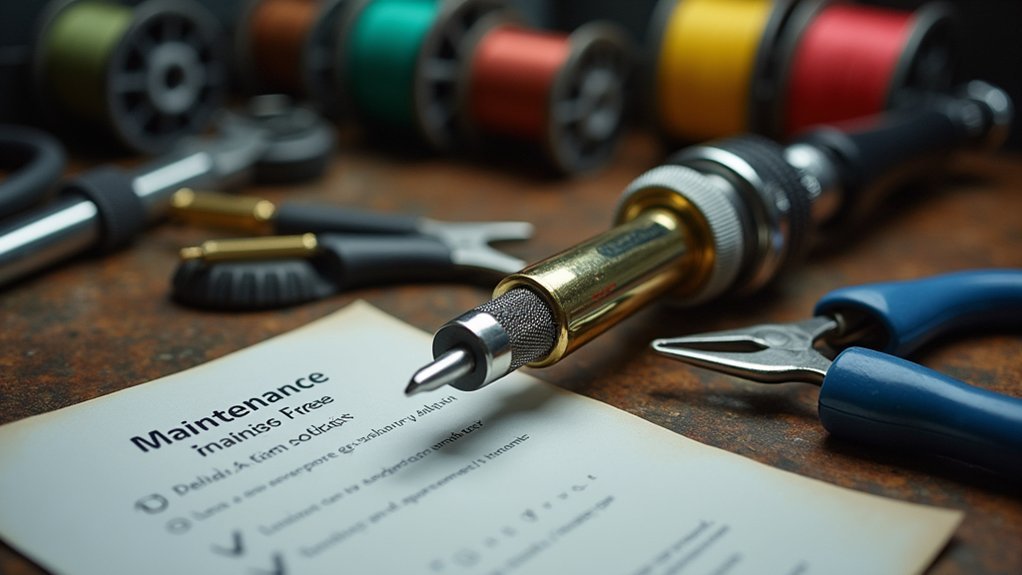When setting up your soldering torch, you’ll want to hand-tighten regulators to prevent thread damage and keep acetylene pressure below 15 PSI to avoid hazards. Always test connections with soap solution to detect leaks through bubbling, and secure tanks with a double chain system to prevent tipping. Open acetylene tanks only a quarter turn for emergency closure, and inspect hoses regularly for wear. These fundamentals will help you master the complete setup process.
Proper Tank Regulation and Safety Setup

When setting up your soldering torch, you’ll first need to securely attach the regulators to your gas tanks using an adjustable spanner.
Hand tighten the connections without applying excessive force to prevent damage to the threads or fittings.
After attachment, check for leaks by applying a soap and water mixture to all joint connections.
Look for bubbles that indicate gas escaping. If you discover any leaking tanks, immediately move them outside for safety.
Be certain to maintain pressure settings below 15 PSI during operation to avoid polymerization hazards.
A recommended setting of around 10 PSI guarantees safe usage.
When opening acetylene tanks, turn the valve only a quarter turn.
This allows for quick emergency closure while providing adequate gas flow for your soldering work.
Leak Detection Using Soap Solution Testing
One of the most critical safety steps involves testing all connections with a simple soap solution to identify potentially dangerous gas leaks. Mix liquid soap with water to create your leak detection solution, then apply it generously to all joints and connections. Watch carefully for bubbles that indicate escaping gas.
| Step | Action | Result |
|---|---|---|
| 1 | Apply soap solution to connections | Bubbles appear if leak exists |
| 2 | Check during initial setup | Guarantees safe operation from start |
| 3 | Recheck after adjustments | Maintains system integrity |
| 4 | Move leaking tanks outside immediately | Prevents hazardous indoor situations |
If you detect any leaks, immediately take tanks outside and never transport them in enclosed vehicles. Regular leak detection testing during maintenance prevents dangerous situations.
Secure Tank Anchoring and Storage Methods

After completing your leak detection testing, you’ll need to establish a robust anchoring system that keeps your gas tanks stable and secure.
Use a double chain system to prevent tipping or movement, especially if you’re in an earthquake-prone area. Before chaining, check that your tank threads are properly aligned and tightened to guarantee consistent gas flow.
Store your tanks outdoors and away from flammable materials to reduce fire hazards from potential leakage.
Never store leaking tanks indoors—immediately move them outside to prevent dangerous gas accumulation.
When transporting tanks, use appropriate vehicles that comply with safety regulations.
This proper anchoring and storage approach protects your equipment while maintaining safe operating conditions for your soldering work.
Pressure Settings and Connection Guidelines
Setting your torch’s pressure correctly forms the foundation of safe soldering operations. Keep acetylene pressure below 15 PSI to prevent dangerous polymerization, with 10 PSI being your ideal target. Hand tighten all regulator connections without excessive force to protect threads while ensuring proper seals.
Your next step involves opening acetylene tanks only a quarter turn for enhanced safety and emergency accessibility. After setup, test all connections using soap and water mixture, watching for telltale bubbles that reveal gas leaks.
| Component | Pressure Setting | Connection Method | Safety Check | Monitoring |
|---|---|---|---|---|
| Acetylene | 10 PSI max | Hand tighten | Soap test | Gauge watch |
| Regulator | Below 15 PSI | No force | Bubble check | Pressure drop |
| Tank valve | Quarter turn | Gentle grip | Visual inspect | Regular scan |
| Joints | Stable reading | Proper seal | Leak detection | Continuous |
| Gauges | Steady levels | Secure fit | Connection test | Active |
Regular Equipment Maintenance and Inspection

Five critical maintenance practices will keep your soldering torch operating safely and efficiently throughout its service life.
First, inspect your hoses regularly for wear, vulnerabilities, and damage signs, replacing them every five years.
Second, clean torch tips frequently using pipe cleaners to prevent debris buildup that restricts gas flow.
Third, monitor pressure gauges consistently and watch for unexpected pressure drops indicating potential leaks.
Fourth, address unusual lighting sounds immediately, as they’re important things signaling equipment problems requiring attention.
Fifth, familiarize yourself thoroughly with your specific equipment’s operation and maintenance requirements.
Knowledge of proper handling considerably reduces accident risks while enhancing overall safety during use.
Frequently Asked Questions
What Is the Best Advice for Soldering Components?
You’ll achieve the best soldering results by cleaning components thoroughly, applying flux before heating, using appropriate lead-free solder, maintaining steady hand control, and letting joints cool naturally to prevent damage.
Is a Propane Torch Hot Enough to Solder?
Yes, you’ll find a propane torch is hot enough for most soldering tasks. It reaches 3,600°F, easily melting lead-tin solder at 361°F, making it perfect for plumbing and general applications.
What Are the Four Steps of Soldering?
You’ll clean the surfaces first, then apply flux to prevent oxidation. Next, you’ll heat the joint until solder flows, and finally inspect the cooled joint for quality.
How to Start Practicing Soldering?
Start practicing soldering by gathering clean materials, setting up your torch safely with proper pressure settings, and working on scrap pieces first. Focus on steady hand control and even heat distribution before attempting actual projects.
In Summary
You’ve got the essential knowledge to set up your soldering torch safely and effectively. Remember, you can’t skip the safety checks—they’re what’ll keep you protected while you work. Don’t rush through tank regulation or leak testing, and always maintain your equipment properly. With these five tips mastered, you’ll have a reliable, safe setup that’ll serve you well on every project you tackle.





Leave a Reply